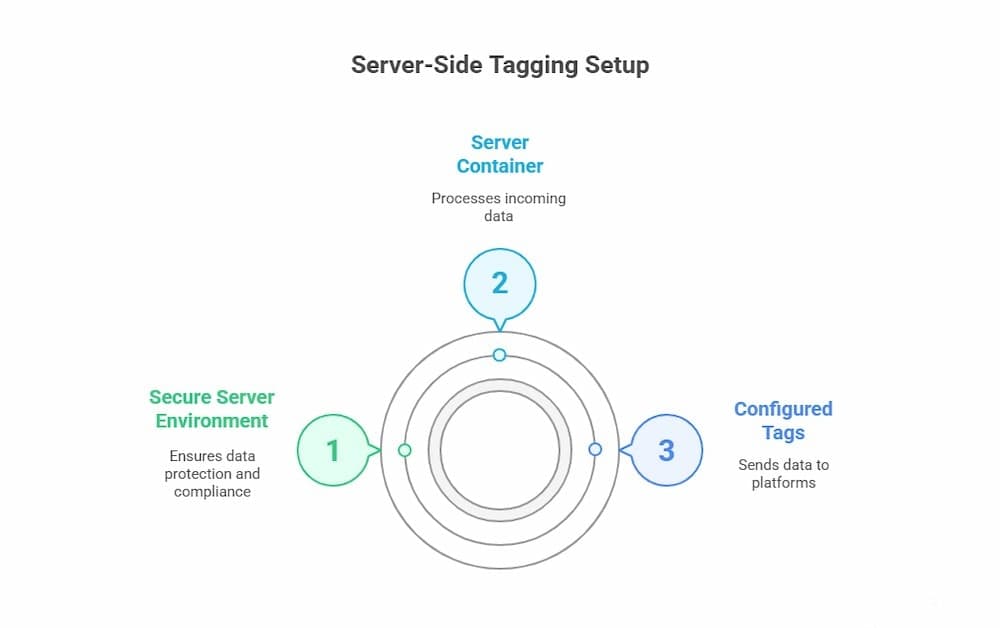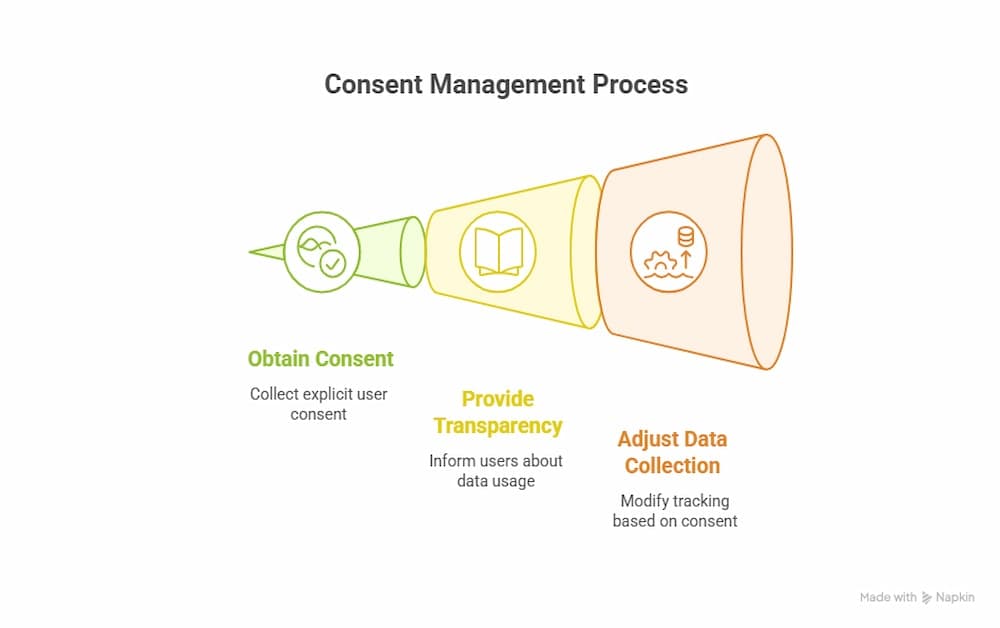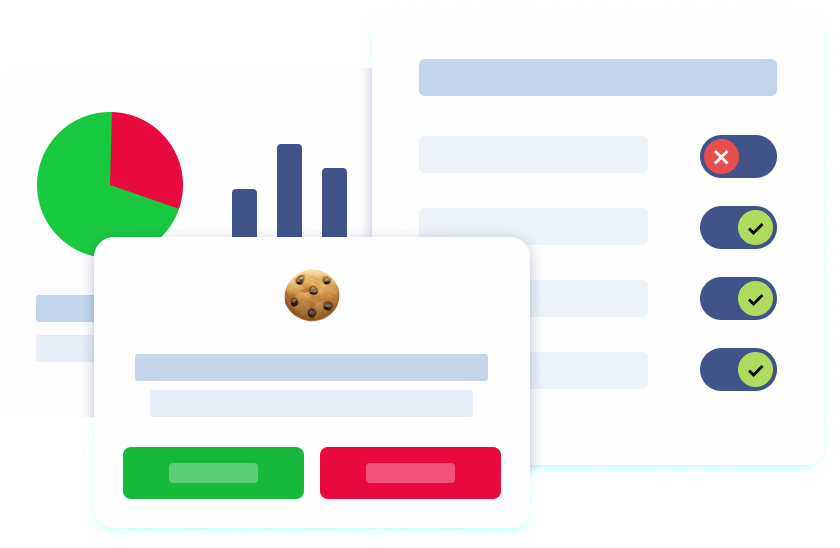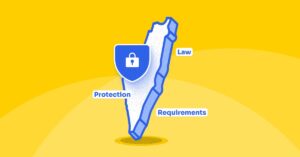Introduction
Server-side tracking is a method of collecting data about user interactions directly on the server, rather than through the user’s browser. Client-side tagging involves tags running in the user’s browser to collect data directly from the user’s device. This approach enhances data privacy and security by reducing exposure on the client side. By shifting data processing from the user’s device to a controlled server environment, organizations can gain full control over data flow and ensure compliance with data protection regulations. Server-side tracking can help mitigate compliance risks associated with exposing data in the user’s browser.
Unlike client-side tracking, which relies on scripts running in the user’s browser, server-side tracking processes data on the server, minimizing the risk of unauthorized data access and improving data accuracy. Client-side tags are traditionally used for measuring conversions and targeting ads, but face challenges from ad blockers and browser restrictions. This method supports responsible data collection practices aligned with privacy standards, allowing organizations to gather user insights responsibly while respecting user consent and data privacy.
Benefits of Server-Side Tagging
Server-side tagging offers several benefits, including improved data accuracy and control over user interactions. By processing data on the server, organizations can filter and customize the collected data before it is sent to third-party platforms, ensuring that only necessary information is shared. This approach allows organizations to keep certain personal data within their own infrastructure, enhancing privacy compliance. This level of control reduces the risk of unauthorized data access and helps prevent unlawful data processing.
Additionally, server-side tagging enables organizations to maintain robust consent management processes. By centralizing data collection and processing, organizations can ensure that user consent is respected and that data usage complies with regulations such as GDPR and CCPA. This approach also enhances data quality by reducing the impact of browser restrictions and ad blockers on data collection.
Server-Side Tagging vs. Traditional Methods
Server-side tagging refers to managing tracking tags on dedicated servers rather than in the user’s browser.
Server-side tagging differs from traditional client-side tracking methods, which rely on the user’s browser to collect data. Client-side tracking is vulnerable to browser restrictions, ad blockers, and third-party cookie limitations, which can lead to data loss and inaccuracies. In contrast, server-side tagging uses a server-to-server connection to collect and process data, providing more accurate and reliable results. Server-side tracking entails sending data to and managing it within a server environment before it reaches endpoints, rather than sending it directly from the user’s device.
This approach also enables better data control and compliance with regulations like GDPR and CCPA. By processing data on the server, organizations can minimize the exposure of sensitive information and ensure that tracking data is more secure and reliable, and that data collection aligns with user consent. Furthermore, server-side tagging reduces the load on the user’s browser, improving website performance and user experience.
Server-side data collection has evolved to address privacy and accuracy challenges posed by traditional client-side methods.

Implementing Server-Side Tagging
Implementing server-side tagging requires a tag management system and a server environment managed by the organization. The initial data collection step involves setting up tracking tags on the server, which then collect and process data. Organizations can implement server-side tagging using tools like Google Tag Manager or by developing a custom solution. To implement server-side tracking, you can use available integrations and support from platforms like Piwik PRO, which streamline the process and offer technical guidance.
A typical server-side tagging setup includes the following components:
- A server container to receive and process incoming data from the user’s browser before sending it to analytics and marketing platforms.
- Configured tags within the server container to send data to analytics and marketing platforms.
- A secure server environment to manage data processing and ensure compliance with data protection regulations.
By implementing server-side tagging, organizations can gain full control over data flow and enhance data privacy and security. A well-designed server-side tracking setup simplifies integration, enhances security, and improves data accuracy.
Role of Google Tag Manager
Google Tag Manager (GTM) plays a crucial role in implementing server-side tagging. GTM provides a platform for managing tracking tags and configuring data collection and processing. By using GTM, organizations can set up server-side tagging and integrate it with other Google tools, such as Google Analytics.
GTM also enables organizations to manage consent and ensure compliance with data protection regulations. With features like Consent Mode, GTM allows organizations to adjust data collection based on user consent, ensuring that tracking tags are only activated when appropriate. This integration supports robust consent management processes and enhances data privacy.
Data Collection and Usage
Server-side tagging collects data about user interactions, such as page views, clicks, and conversions. This data is then processed and stored on the server, providing a secure and reliable way to collect and analyze data. Organizations can use this data to gain insights into user behavior, track conversions, and optimize marketing campaigns.
By using server-side tagging, organizations can ensure that data collection and usage are compliant with regulations and respect user privacy. Server-side tagging also plays a key role in enabling data flow between systems while maintaining compliance with privacy regulations. This approach also allows for more accurate data collection by reducing the impact of browser restrictions and ad blockers. Furthermore, server-side tagging enables organizations to customize data processing, ensuring that only necessary information is collected and shared.
Ensuring Compliance with Regulations
Ensuring compliance with regulations is critical when implementing server-side tagging. Organizations must ensure that they have robust consent management processes in place and that data collection and processing are transparent and secure. Server-side tagging can help organizations comply with regulations like GDPR and CCPA by providing a secure and reliable way to collect and process data.
By using server-side tagging, organizations can demonstrate their commitment to data privacy and protection. This approach allows for better control over data flow and minimizes the risk of unauthorized data access. Additionally, server-side tagging supports data minimization principles by enabling organizations to collect only the data necessary for specific purposes. Server-side tracking statements from industry experts address common myths and misconceptions about compliance, clarifying that while legal and privacy compliance challenges exist, they can be effectively managed through proper data filtering and categorization.

Consent Management
Consent management is a critical aspect of server-side tagging. Organizations must obtain explicit consent from users before collecting and processing their data. Server-side tagging enables organizations to manage consent and ensure that data collection and processing are compliant with regulations.
By using server-side tagging, organizations can provide users with clear and transparent information about data collection and usage. This approach supports robust consent management processes and helps build trust with users. Furthermore, server-side tagging allows organizations to adjust data collection based on user consent, ensuring that tracking tags are only activated when appropriate.
Using Google Analytics
Google Analytics is a popular tool for tracking and analyzing user behavior. Server-side tagging can be integrated with Google Analytics to provide more accurate and reliable data. By using server-side tagging with Google Analytics, organizations can gain insights into user behavior, track conversions, and optimize marketing campaigns. Server-side analytics tracking offers advanced data accuracy and privacy benefits compared to traditional client-side tracking methods.
Google Analytics also provides features for managing consent and ensuring compliance with regulations. By integrating server-side tagging with Google Analytics, organizations can enhance data accuracy and privacy while maintaining compliance with data protection regulations. This approach supports responsible data collection practices and helps organizations make informed decisions based on reliable data.
Overcoming Challenges
Implementing server-side tagging can pose several challenges, including technical complexity and scalability issues. Organizations must ensure that their server environment is managed and secured properly to prevent unauthorized data access. Server-side tagging also requires ongoing maintenance and updates to ensure that it remains compliant with regulations and continues to provide accurate and reliable data.
By working with technical web analysts, who bring specialized expertise and practical experience in web analytics roles, and using tools like Google Tag Manager, organizations can overcome these challenges and ensure successful implementation. A technical web analyst’s guide is invaluable in assisting organizations with implementing server-side tracking and integrations, providing professional guidance and seamless support during technical integrations. Proper planning and resource allocation are essential for addressing technical complexities and ensuring that server-side tagging supports organizational goals. Additionally, organizations should stay informed about regulatory changes and best practices to maintain compliance and data quality.
Best Practices for Server-Side Tracking
Best practices for server-side tracking include ensuring that data collection and processing are transparent and secure. Organizations should also implement robust consent management processes and ensure that data collection and usage are compliant with regulations. Server-side tracking should be integrated with other tools and systems to provide a comprehensive view of user behavior.
By following these best practices, organizations can ensure that server-side tracking is effective and compliant. This approach supports responsible data collection and helps organizations gain valuable insights into user behavior while respecting user privacy. Furthermore, regular audits and assessments can help identify areas for improvement and ensure that server-side tracking continues to meet organizational needs.
Common Use Cases
Common use cases for server-side tracking include tracking user behavior, measuring conversions, and optimizing marketing campaigns. Server-side tracking can also be used to collect data for web analytics, track user interactions, and provide insights into user behavior. Server-side tagging can more accurately track user behavior for analytics and marketing purposes. Compared to client-side tracking implementation, server-side tracking offers enhanced compliance and data filtering, which is crucial for privacy and legal requirements. By using server-side tracking, organizations can gain a better understanding of their users and improve their overall customer experience.
Server-side tracking can also be used to comply with regulations and ensure that data collection and usage are transparent and secure. This approach supports responsible data collection practices and helps organizations build trust with users. Additionally, server-side tracking can be used to enhance data accuracy and reliability, supporting informed decision-making and effective marketing strategies.
Measuring Success
Measuring the success of server-side tracking involves assessing key performance indicators (KPIs) such as data accuracy, user engagement, and conversion rates. By comparing metrics gathered through server-side tagging to those collected through traditional client-side tracking, organizations can evaluate improvements in data quality and reliability.
Additionally, it’s essential to monitor the server environment for stability, performance, and security. Tracking the rate of data requests, latency in processing data, and instances of unauthorized data access can help optimize the server-side setup. Using tools like Google Analytics, businesses can tie conversion data and user behavior insights directly to marketing effectiveness, allowing for continuous improvement of digital strategies.
Periodic reviews of the consent management system and compliance documentation should also be included in measurement practices. Tracking opt-in rates, consent revocation trends, and jurisdiction-specific compliance can provide deeper insights into how user privacy is being managed and respected.
Future of Server-Side Tagging
As privacy regulations evolve and browser restrictions increase, server-side tagging is expected to become the standard for compliant and accurate data collection. The shift toward a privacy-first digital ecosystem, where third-party cookies are deprecated and data control is prioritized, will make server-side tracking a vital component of any data strategy.
Emerging technologies and platforms will likely offer more integrated and user-friendly solutions for server-side tagging. This includes automated consent frameworks, advanced encryption protocols, and standardized server-to-server APIs for seamless data transmission. Organizations that adopt server-side strategies early will be better positioned to adapt to future regulatory changes and user expectations.
Forward-looking teams are also investing in machine learning models hosted in secure environments to analyze user behavior while preserving privacy. These models rely on data collected server-side, making the case even stronger for a robust and scalable setup.
Scalability and Performance
Scalability and performance are critical factors in ensuring long-term success with server-side tracking. As web traffic increases, the server infrastructure must be capable of handling high volumes of data requests without degradation in user experience or data quality.
Optimization techniques such as load balancing, data caching, and asynchronous processing can help ensure that tracking does not interfere with application speed or responsiveness. A server-side setup hosted on cloud platforms like Google Cloud Platform or AWS can offer scalability and flexibility to handle data processing at scale.
Furthermore, performance monitoring tools should be employed to continuously assess the responsiveness and stability of the tracking environment. Ensuring a fast and reliable server-side implementation also minimizes the risk of data loss during peak traffic periods.
Integration with Other Tools
To unlock the full potential of server-side tagging, it must be integrated seamlessly with other analytics and marketing tools. Integrating with platforms like Google Analytics, CRM systems, advertising platforms, and consent management tools ensures that data flows securely and consistently across the tech stack.
A centralized data flow managed through a server-side tagging setup allows organizations to enrich first-party data, track user journeys more accurately, and respond in real-time to behavioral triggers. This integration also allows categorizing data attributes based on consent status, ensuring that no unauthorized data processing occurs.
Additionally, server-side tagging supports advanced personalization strategies by allowing data to be shared selectively and securely with third parties while maintaining full control over what data is transmitted and when.
Conclusion
Server-side tagging offers a powerful, privacy-conscious alternative to traditional client-side tracking. It enables organizations to maintain control over their data, improve accuracy, and ensure regulatory compliance. By shifting the data collection layer to a secure server environment, companies can reduce exposure to browser restrictions, ad blockers, and the limitations of third-party cookies.
Implementing server-side tagging entails thoughtful planning, robust consent management integration, and ongoing monitoring, but the benefits far outweigh the challenges. By investing in server-side tracking methods and integrating privacy considerations early, businesses can gather user insights responsibly, prevent unlawful data processing, and deliver value to users and regulators alike.
As data protection regulations continue to tighten and public awareness of privacy issues grows, server-side tracking stands as a future-proof solution. Organizations that embrace this evolution will not only gain more accurate data and insights but also demonstrate a strong commitment to ethical and compliant data practices.



